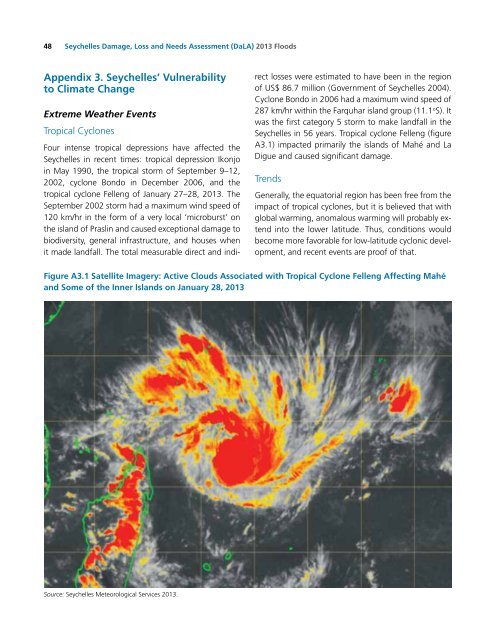Seychelles Damage, Loss, and Needs Assessment (DaLA ... - GFDRR
Seychelles Damage, Loss, and Needs Assessment (DaLA ... - GFDRR
Seychelles Damage, Loss, and Needs Assessment (DaLA ... - GFDRR
Create successful ePaper yourself
Turn your PDF publications into a flip-book with our unique Google optimized e-Paper software.
48<br />
<strong>Seychelles</strong> <strong>Damage</strong>, <strong>Loss</strong> <strong>and</strong> <strong>Needs</strong> <strong>Assessment</strong> (<strong>DaLA</strong>) 2013 Floods<br />
Appendix 3. <strong>Seychelles</strong>’ Vulnerability<br />
to Climate Change<br />
Extreme Weather Events<br />
Tropical Cyclones<br />
Four intense tropical depressions have affected the<br />
<strong>Seychelles</strong> in recent times: tropical depression Ikonjo<br />
in May 1990, the tropical storm of September 9–12,<br />
2002, cyclone Bondo in December 2006, <strong>and</strong> the<br />
tropical cyclone Felleng of January 27–28, 2013. The<br />
September 2002 storm had a maximum wind speed of<br />
120 km/hr in the form of a very local ‘microburst’ on<br />
the isl<strong>and</strong> of Praslin <strong>and</strong> caused exceptional damage to<br />
biodiversity, general infrastructure, <strong>and</strong> houses when<br />
it made l<strong>and</strong>fall. The total measurable direct <strong>and</strong> indirect<br />
losses were estimated to have been in the region<br />
of US$ 86.7 million (Government of <strong>Seychelles</strong> 2004).<br />
Cyclone Bondo in 2006 had a maximum wind speed of<br />
287 km/hr within the Farquhar isl<strong>and</strong> group (11.1 o S). It<br />
was the first category 5 storm to make l<strong>and</strong>fall in the<br />
<strong>Seychelles</strong> in 56 years. Tropical cyclone Felleng (figure<br />
A3.1) impacted primarily the isl<strong>and</strong>s of Mahé <strong>and</strong> La<br />
Digue <strong>and</strong> caused significant damage.<br />
Trends<br />
Generally, the equatorial region has been free from the<br />
impact of tropical cyclones, but it is believed that with<br />
global warming, anomalous warming will probably extend<br />
into the lower latitude. Thus, conditions would<br />
become more favorable for low-latitude cyclonic development,<br />
<strong>and</strong> recent events are proof of that.<br />
Figure A3.1 Satellite Imagery: Active Clouds Associated with Tropical Cyclone Felleng Affecting Mahé<br />
<strong>and</strong> Some of the Inner Isl<strong>and</strong>s on January 28, 2013<br />
Source: <strong>Seychelles</strong> Meteorological Services 2013.

















